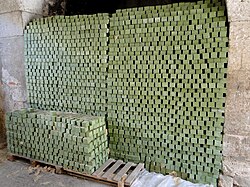Aleppo soap

Aleppo soap (also known as savon d'Alep, laurel soap, Syrian soap, or ghar soap, the Arabic word غَار, meaning 'laurel') is a handmade, hard bar soap associated with the city of Aleppo, Syria. Aleppo soap is classified as a Castile soap as it is a hard soap made from olive oil and lye, from which it is distinguished by the inclusion of laurel oil.
History
[edit]The origin of Aleppo soap is unknown. Unverified claims of its great antiquity abound,[1][2] such as its supposed use by Queen Cleopatra of Egypt and Queen Zenobia of Syria.[3] Although it has been claimed that soap-making was introduced to the West from the Levant after the First Crusades, in fact, soap was known to the Romans in the first century AD and Zosimos of Panopolis described soap and soapmaking in c. 300 AD.[4]
Today most Aleppo soap, especially that containing more than 16% of laurel oil, is exported to Europe and East Asia.[5]
Manufacturing process
[edit]This section needs additional citations for verification. (November 2022) |

Traditional Aleppo soap is made by the "hot process". First, the olive oil is brought into a large, in-ground vat along with water and lye. Underneath the vat, there is an underground fire that heats the contents to a boil. Boiling lasts three days while the oil reacts with the lye and water to become a thick liquid soap.

The laurel oil is added at the end of the process, and after it is mixed in, the mix is taken from the vat and poured over a large sheet of waxed paper on the floor of the factory. At this point, the soap is a large, green, flat mass, and it is allowed to cool down and harden for about a day. While the soap is cooling, workers with planks of wood strapped to their feet walk over the soap to try to smooth out the batch and make it an even thickness.

The soap is then cut into cubes. The cubes of soap are stacked in staggered cylinders to allow maximum air exposure. Once they have dried sufficiently, they are put into a special subterranean chamber to be aged for six months to a year. While it is aging, the soap goes through several chemical changes. The free alkaline content of the soap (the alkaline which did not react with the oil during saponification) breaks down upon slow reaction with air. The moisture content of the soap is also reduced, making the soap hard and long-lasting. And lastly, the color of the outside of the soap turns pale gold, while the inside remains green.
Modern Aleppo soaps are manufactured using a "cold process" and contain olive and laurel oils, and may contain a variety of herbs and/or essential oils.
Ingredients
[edit]Aleppo soap is made with olive oil, the oil of the laurel berry (zeit ghar), water, and lye; the concentration of laurel oil, typically 2–20%, determines the quality and cost of the soap.[citation needed] Aleppo soap is biodegradable.[6]
In the 20th century, with the introduction of cold process soap making, soap artisans from Aleppo began introducing a variety of herbs and essential oils to their soaps.
Unlike most soaps, some Aleppo soap will float in water.[citation needed]
Skin care properties
[edit]Aleppo soap can be used daily as soap for washing and shampooing, as face mask, as shaving cream, and for bathing infants and babies.[7] Laurel oil is an effective cleanser, with some antimicrobial,[8] antifungal[9] and anti-itching properties.
See also
[edit]References
[edit]- ^ Mosquin, Daniel (2008-03-26). "Laurus nobilis - Botany Photo of the Day". Botanicalgarden.ubc.ca. Archived from the original on 2012-04-02. Retrieved 2012-07-09.
- ^ "Aleppo Soap, The True Natural Soap". Natural Cosmetic News. Archived from the original on 2012-09-02. Retrieved 2012-07-09.
- ^ Giuliani, Alessandra (2007). Developing Markets for Agrobiodiversity: Securing Livelihoods in Dryland Areas. London: Earthscan. ISBN 9781849770972.
- ^ Partington, James R (1960). A history of Greek fire and gunpowder. JHU Press. p. 307. ISBN 9780801859540.
- ^ Yacoub, Khaled (2010-10-22). "Modern threat to Syria's ancient Aleppo soap industry". Reuters. Retrieved 2012-07-09.
- ^ Al-Darbi, M.M.; Saeed, N.O.; Islam, M.R.; Lee, K. (2003). "Biodegradation of Natural Oils in Seawater" (PDF). Energy Sources. 27 (1–2): 21. CiteSeerX 10.1.1.497.4049. doi:10.1080/00908310490448073. S2CID 7615677.
- ^ Kiechl-Kohlendorfer, Ursula; Berger, Cindy; Inzinger, Romy (2008). "The Effect of Daily Treatment with an Olive Oil/Lanolin Emollient on Skin Integrity in Preterm Infants: A Randomized Controlled Trial". Pediatric Dermatology. 25 (2): 174–8. doi:10.1111/j.1525-1470.2008.00627.x. PMID 18429773. S2CID 19920016.
- ^ Fukuyama, Noriaki; Ino, Chieko; Suzuki, Yumiko; Kobayashi, Noritada; Hamamoto, Hiroshi; Sekimizu, Kazuhisa; Orihara, Yutaka (2011). "Antimicrobial sesquiterpenoids from Laurus nobilis L.". Natural Product Research. 25 (14): 1295–303. doi:10.1080/14786419.2010.502532. PMID 21678158. S2CID 20697261.
- ^ Simić, A.; Soković, M. D.; Ristić, M.; Grujić-Jovanović, S.; Vukojević, J.; Marin, P. D. (2004). "The chemical composition of some Lauraceae essential oils and their antifungal activities". Phytotherapy Research. 18 (9): 713–7. doi:10.1002/ptr.1516. PMID 15478207. S2CID 8172910.
Bibliography
[edit]- Cynthia Zaferatos (2008). "The History Of Olive Oil" (PDF). EUROMED Sustainable Connections Policy Analysis. Anna Lindh Foundation. p. 2. Archived from the original (PDF) on 2012-04-07. Retrieved 2011-10-01 – via Western Washington University.
- Nayak, Shivananda; Nalabothu, Poorna; Sandiford, Steve; Bhogadi, Vidyasagar; Adogwa, Andrew (2006). "Evaluation of wound healing activity of Allamanda cathartica. L. And Laurus nobilis. L. Extracts on rats". BMC Complementary and Alternative Medicine. 6: 12. doi:10.1186/1472-6882-6-12. PMC 1456996. PMID 16597335.
External links
[edit]- Arthur, Golda. Aleppo soap: War threatens an ancient tradition BBC News, 15 May 2013.
- Video of the making of Aleppo Soap, Insider 2019
